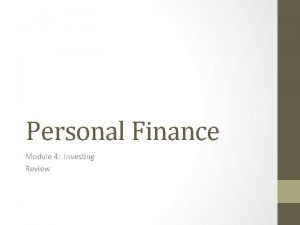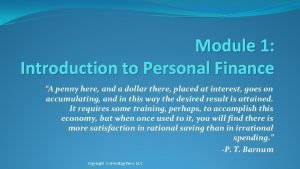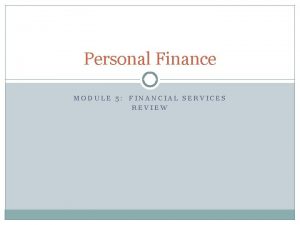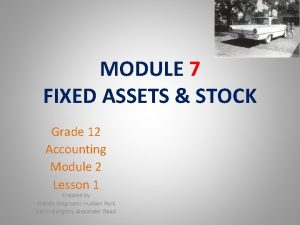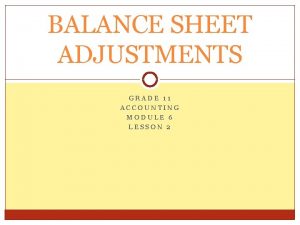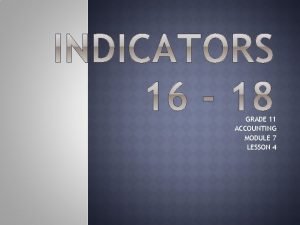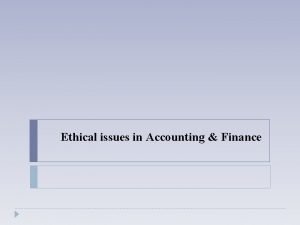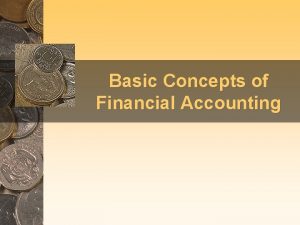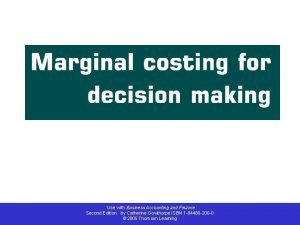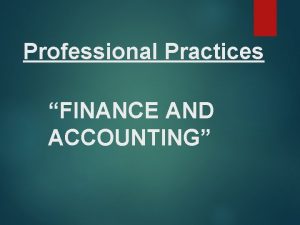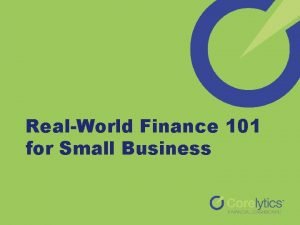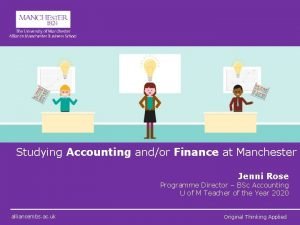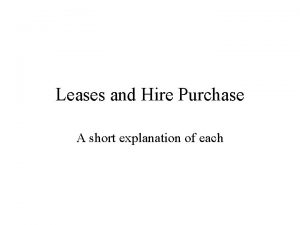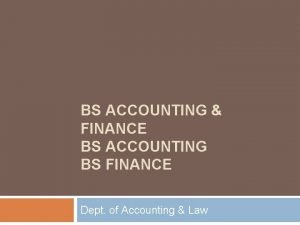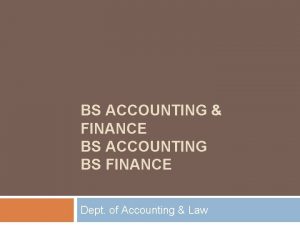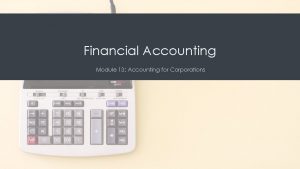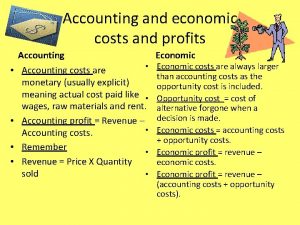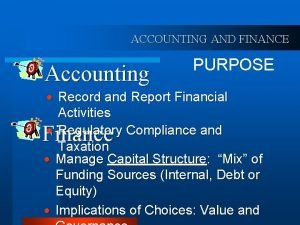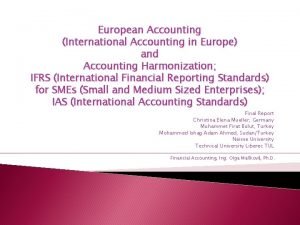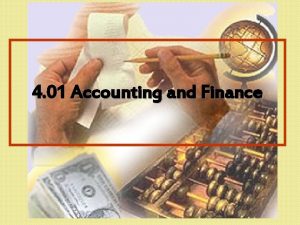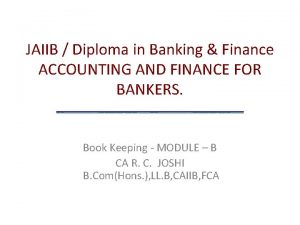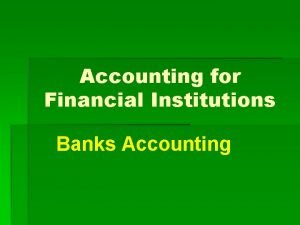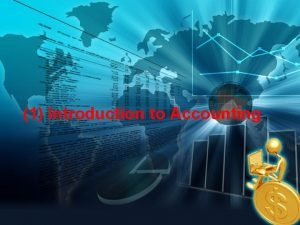MODULE 2 FINANCE AND ACCOUNTING FINANCE AND ACCOUNTING





















- Slides: 21

MODULE 2: FINANCE AND ACCOUNTING

FINANCE AND ACCOUNTING Accounting is the language of financial decisions. It is a continuous process of performance measurement, preparing analysis and reporting the results to decision makers. Ø Accounting has been formalised and structured with the advancement of industry and technology in the modern day. Ø A person who maintains accounts is known as the accountant. Ø The information generated by accounting is used by various interested groups like, individuals, managers, investors, creditors, government, regulatory agencies, taxation authorities, employee, trade unions, consumers and general public.

ACCOUNTING: It is the means of collecting, summarising and reporting in monetary terms, information about the business. FINANCIAL ACCOUNTING: Maintenance of books of accounts with a view to ascertain the profitability and financial status of the business is part of financial accounting. TRANSACTION: A transaction is a stimulus from one person and a related response from another.

Balance Sheet A Balance Sheet is a statement of the financial position of a business which states the assets, liabilities, and owners' equity at a particular point in time. In other words, the balance sheet illustrates your business's net worth. The relationship between them is expressed in this equation: Assets = Liabilities + Equity Assets: assets are typically organized into liquid assets—those that are cash or can be easily converted into cash—and nonliquid assets that cannot quickly be converted to cash, such as land, buildings, and equipment. Liabilities : Liabilities are funds owed by the business, and are broken down into current and longterm categories. Equity: Equity, also known as shareholders' equity, is that which remains after subtracting the liabilities from the assets.

Balance Sheet For a startup business it is a good idea to have an accountant do your first balance sheet, particularly if you are new to business accounting. Balance sheets are easy to do if you use accounting software. Accounting software designed for small businesses can keep track of all your accounting information and generate balance sheets, cash flow statements, and other reports automatically as needed.

Break Even Point A company's breakeven point is the point at which its sales exactly cover its expenses It has Three variables: Fixed costs: Costs that are independent of sales volume, such as rent Variable costs: Costs that are dependent on sales volume, such as the cost of manufacturing the product Selling price of the product Breakeven Point in Units = Fixed Costs ÷ (Price - Variable Costs)

At the break even level, Total Revenue = Total Expenses The formula for calculating break even level is: Fixed Cost (Per month) Break Even Volume (Per Month) = --------Gross Margin Per Unit

Simple Example Let us understand this further through a simple example of Ram and his tea vending business considering the following facts or assumptions: Ram, who was earlier working in a restaurant, has now decided to start a tea vending business. He was getting Rs. 300/- per day as his wages, while working in the restaurant. For starting a tea stall, he needs the following items: • Mobile hand cart • Vessels • Stove • Fuel • Strainer • Thermos flask etc. for which he needs Rs. 12, 000/-. He will need to buy the initial supply of milk, sugar, cups, tea leaves for which he will need around Rs. 1, 000/-.

• Ram already has Rs. 1, 000/- which he used for buying various consumable items. • He borrowed Rs. 12, 000/- from a friend agreed to pay him Rs. 4/- per day as interest @ approximately 12% per annum • The cost of producing tea from one litre milk for Ram is as shown below: One Litre Milk = Rs. 30/- Two Litre Water = Rs. 2 /- Sugar (300 gms) Tea leaves (100 gms) = = Rs. 30 /- Rs. 20 /- Fuel = Rs. 2 /- Total = Rs. 84 /-

• From this, Ram will be able to get 30 cups of 100 ml quantity. • Out of this, lets take into account some wastage such as evaporation while boiling water and milk, spillage etc. • Hence, the actual number of cups of tea, which can be made from one litre of milk will come down to 28 cups. • That is Rs. 3/- per cup (84/ 28) • Each disposable cup = 50 paise • So, the unit cost= Rs. 3. 50/- per cup • After market survey, Ram decides to sell his tea at Rs. 5/- per cup. • Gross Profit or Margin per cup is Rs. 1. 5/- (= 5. 00 - 3. 50)

• Ram employs a helper on a daily wage of Rs. 99/ • He pays no rent but pays Rs. 10/- per day as protection money • He pays interest of Rs. 4/- per day. • Also his own wages of Rs. 300/- per day • Ram knows that he needs to recover the initial investment of Rs. 12, 000/- over a period of time. He decides to do this over 5 years or 60 months. This translates to approximately Rs. 7/- per day. Total fixed cost per day for Ram is: (Rs. 300 + Rs. 99 + Rs. 10 + Rs. 4 + Rs. 7) = Rs. 420/-

On Day 1, Ram sells 200 cups, the Gross Margin is Rs 300/- and Total Fixed Expenses is Rs. 420/-. So on the first day there is a loss of Rs. 120/ (420 - 300) On Day 2 , Ram sells 280 cups, the Gross Margin is 420 and Total Fixed Expenses is Rs. 420/-. So on the second day, there is neither a loss nor profit, because total revenue is equal to the total expenses. At the level of sales of Day 2, Ram breaks even (no profit or loss). This is 280 cups per day.

Number of Cups Sold Sales Revenue at Rs. 5/- a cup Cost of Goods Sold (Variable Cost) at Rs. 3. 5/ a cup Gross Margin Fixed Expenses Helper Wage Own Wage Interest Day 1 Day 2 Day 3 200 280 500 1, 000 A 1, 000 1, 400 2, 500 5, 000 B 700 980 1, 750 3, 500 C=A-B 300 420 750 1, 500 99 300 4 10 10 7 420 (120) 0 330 1, 080 Rent (Protection Money) Depreciation Total Fixed Expenses Profit/(Loss) before tax D E= C-D Day 4

Every business requires an adequate amount of capital/ finance to fund the initial expenses. There might be a need for additional capital over and above your savings. Loans provided by Government and various banks help to get financial assistance in such cases.

1. Always remember to clear your dues on time. 2. Always take care that, after a credit card dues or loan is settled, next Credit Information reports (CIRs) reflects the same. 3. Always have a balanced mix of secured and unsecured loans. 4. Beware of fluctuations in Income & low balance in the banks at the end of the month. Low balance can lead to lower scores. 5. CIRs may be taken at least six months prior to approaching for a loan or its enhancement such that if any area requires to be attended, the same can be done. 6. Do your spending or repayments (always make payment on or before due date) carefully/timely. It impacts scores. 7. Ensure that your credit card dues & payments get reflected in your statement. 8. Make payment through RTGS/NEFT/IMPS. 9. Make a provision on working capital account for interest posting. 10. Sufficient credit every month to service interest of particular month. 11. Maintain list of cheques issued. 12. Check that scheduled payment got debited. 13. Clear the dues before going on holiday. 1. 2. 3. 4. 5. 6. 7. 8. 9. 10. 11. 12. 13. Default on your loan nstalments. Making late payments or defaulting on your dues negatively affects your score. Approach many banks simultaneously, each search may affect your chances. Open many new accounts at one go or open new account without knowledge of your banker. This may not be viewed positively by lenders. Apply for loan without proper planning. Issue cheque if clear balance is not there. Overdraw the account. Disconnect the calls of banker. Forget your due date of all credit facilities. Pay a single penny of penal interest. It affects your credit habit. Withdraw cash for personal use. Take credit from unknown person. Just rely on memory. Do schedule your payment on system. Just rely on your employee to clear your dues on time.

Pradhan. Mantri Mudra Yojana is a special scheme set up by the Government of India through MUDRA (a subsidiary of SIDBI). MUDRA supports institution to extend loans to the non-corporate non-farm sector income generating activities of micro and small entities (subject to those enterprises with credit needs below 10 lakhs). The interventions have been named 'Shishu', 'Kishor' and 'Tarun' to signify the stage of growth. Shishu Kishor Tarun Loans upto Rs. 50, 000 to 5 lakh Loans upto Rs. 5 lakh to 10 lakh For details visit Udyamimitra website (https: //udyamimitra. in/Mudra. Loan) Stand up India Loans for SC / ST and Women Entrepreneurs The scheme was launched in 2015 to promote funding for green-field projects (first time ventures) promoted by SC/ST/Women entrepreneurs. The scheme facilitates bank loans between Rs 10 lakh and Rs 1 crore. The maximum repayment tenure for Stand Up India Loans is 7 years. The bank may provide you moratorium on principal repayment for up to 18 months.

Loan Scheme Eligibility Ø The loan is available to only women borrowers or to Scheduled Caste (SC) or Scheduled Tribe (ST) Borrowers. Ø You must be above 18 years of age. Ø The loan must be used to set up a greenfield enterprise. i. e. , this must be the first venture of the borrower. Ø The enterprise should be in manufacturing, services or trading sector. Ø If the applicant is a non-individual (say a company), at least 51% of the shareholding or the controlling stake must be owned by the SC/ST or woman entrepreneur. Ø The Borrower shouldn’t be in default with any bank or financial institution. How to Apply for Stand up India Loans? Through Stand Up India Portal ( https: //www. standupmitra. in/ )

What are Taxes and who levies them? A tax is a financial charge or other levy imposed upon a taxpayer (an individual or legal entity) by a state or the functional equivalent of a state such that failure to pay is punishable by law. Income Tax Direct taxs Corporation Tax Types of Tax Indirect taxs Property Tax

Goods and Services Tax (GST) The goods and services tax (GST) paves way for a single national market by merging several central and state taxes. It is also expected to make Indian products more competitive in both domestic and international markets and at the same time, it will be transparent and easier to administer. Components of GST CGST: SGST: IGST: Collected by the Central Government on an intra-state sale Collected by the State Government on an intra-state sale Collected by the Central Government for inter-state sale

MSME Act 2006 MSME (Micro, Small & Medium Enterprises) are classified in two ways : Ø Manufacturing Enterprises: Those engaged in manufacturing or production of goods Ø Service Enterprises: Those engaged in providing or rendering of services. Enterprises Manufacturing Sector(Investment in plant & machinery) Service Sector(Investment in equipment’s) Micro Enterprises Does not exceed twenty-five lakh rupees Does not exceed ten lakh rupees Small Enterprises More than twenty-five lakh rupees but does not exceed five crore rupees More than ten lakh rupees but does not exceed two crore rupees Medium Enterprises More than five crore rupees but does not exceed ten crore rupees More than two crore rupees but does not exceed five crore rupees

 C device module module 1
C device module module 1 Module 4: investing test answer key
Module 4: investing test answer key Personal finance module
Personal finance module Personal finance module
Personal finance module Accounting grade 12 fixed assets
Accounting grade 12 fixed assets Grade 11 accounting adjustments
Grade 11 accounting adjustments Grade 11 accounting module 1
Grade 11 accounting module 1 Agricultural accounting and finance kansas
Agricultural accounting and finance kansas Accounting ethical issues
Accounting ethical issues Implementing strategies marketing finance/accounting
Implementing strategies marketing finance/accounting Basic concepts of financial accounting
Basic concepts of financial accounting Business accounting and finance catherine gowthorpe
Business accounting and finance catherine gowthorpe Finance and accounting in professional practice
Finance and accounting in professional practice International accounting and finance
International accounting and finance Accounting vs finance
Accounting vs finance Baecon accounting and finance
Baecon accounting and finance Hire purchase accounting treatment
Hire purchase accounting treatment Intermediate accounting chapter 1
Intermediate accounting chapter 1 What is computerised accounting system
What is computerised accounting system Materiality concept
Materiality concept Social responsibility of management ppt
Social responsibility of management ppt Module 5 supply and demand introduction and demand
Module 5 supply and demand introduction and demand

